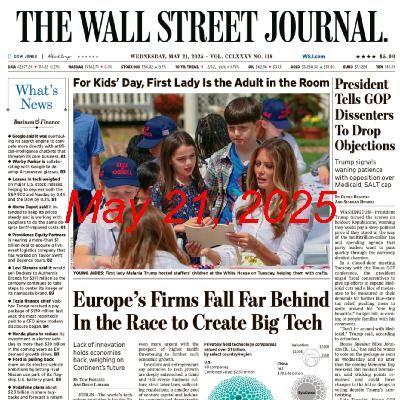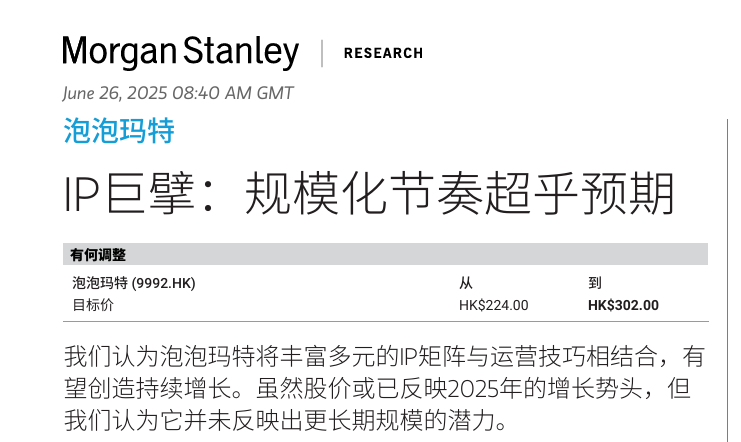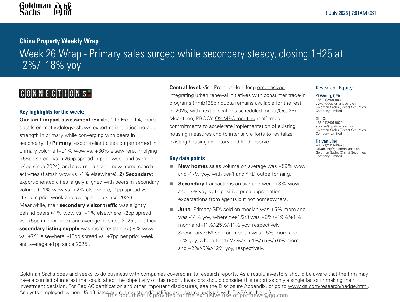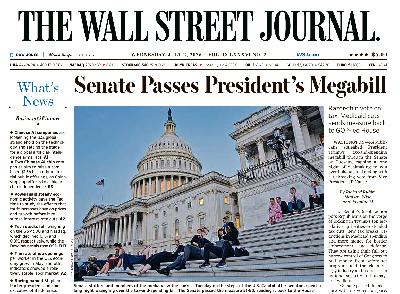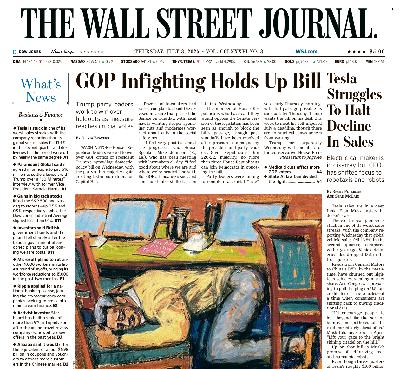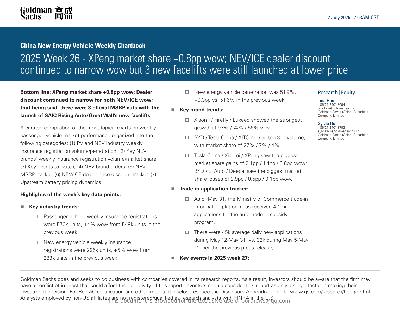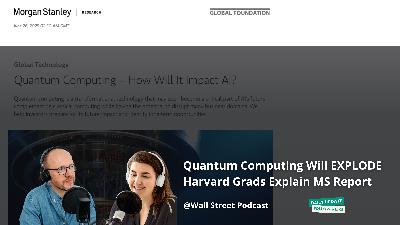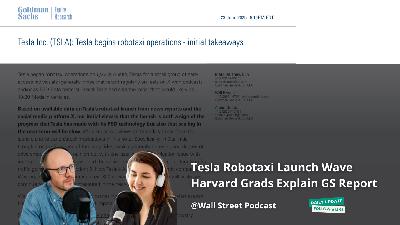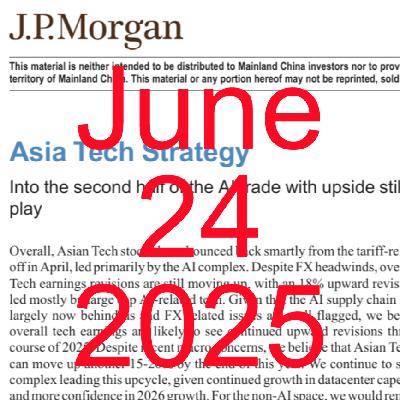Discover the Wall Street Journal Podcast
the Wall Street Journal Podcast

the Wall Street Journal Podcast
Author: Wall Street Podcast
Subscribed: 19Played: 50Subscribe
Share
© Copyright 2025 All rights reserved.
Description
Two CFA professionals crack open everyday’s Wall Street Journal, distilling the essential headlines, the biggest winners and losers.
The show is conversational—no jargon, no rambling—but backed by decades of combined experience on the research desk and trading floor.
Perfect for your commute, coffee break, or pre-market scan.
The show is conversational—no jargon, no rambling—but backed by decades of combined experience on the research desk and trading floor.
Perfect for your commute, coffee break, or pre-market scan.
100 Episodes
Reverse
The Wall Street Journal (May 21, 2025) discuss various aspects of the current global economic and technological landscape, highlighting the dominant influence of AI on industries and daily life.
It also examines shifts in the automotive market.
Finally, it touches upon investment strategies.
[FRESH ANALYSIS - June 26, 2025] Morgan Stanley just released a bombshell report on Pop Mart, and the numbers are staggering. This Chinese toy company has achieved viral global success that even surprised analysts, with Labubu's popularity now rivaling Harry Potter and Disney.
In this deep dive of the latest June 2025 Morgan Stanley report, we'll explore:
✅ Why Morgan Stanley upgraded Pop Mart's target P/E from 40x to 51x
✅ How sales are projected to grow from $3.6B (2025) to $6B (2027)
✅ The social media phenomenon driving 70%+ female customer engagement
✅ NEW: Pop Land theme parks generating $500M-$800M revenue run rate
✅ BREAKING: POPOP jewelry launch and Pop Blocks expansion into US markets
✅ Why Pop Mart's DTC model generates $0.36 profit per $1 sales vs $0.07 for traditional IP licensing
June 2025 Update includes:
Latest Q1 2025 growth numbers (80%+ YoY growth maintained)
New business segment performance data
Updated risk assessment including US-China trade implications
But it's not all smooth sailing. We'll also cover the risks: supply chain pressures, counterfeit products, US-China trade tensions, and the challenge of sustaining viral growth.
Is Pop Mart the next Disney, or just another fad? Let's break down what makes this Chinese company the world's fastest-growing consumer brand based on the most current June 2025 analysis.
Morgan Stanley releases groundbreaking "Humanoid Horizons" research report analyzing the explosive global humanoid robotics industry.
Market Scale Projection:
Report forecasts global humanoid robot inventory reaching 1 billion units by 2050, generating nearly $5 trillion in annual revenue - exceeding the entire global automotive industry. China projected to account for 302 million units.
China's Competitive Advantages:
Data shows China leads in patent applications with 6,393 filings over five years, surpassing US (1,484) and Japan (1,109). Among 114 notable global humanoid robots, Chinese products represent 59%. Government backing includes approximately 187 billion RMB ($26 billion) in dedicated funding.
Industry Development Status:
May 2025 marked record-high financing activity in China with 25 deals. Unitree completed Series C funding at $1.7 billion valuation, backed by Geely, Ant Group, Tencent. Product pricing trending downward - Unitree previewing sub-$10,000 26-DOF humanoid.
Technology Ecosystem Building:
Major tech companies accelerating open-source initiatives: Apple released EgoDex manipulation dataset, Google launched Gemini Robotics on-device solution, Meta unveiled 1.2 billion parameter V-JEPA 2 world model, Huawei Cloud introduced CloudRobo platform. These efforts aim to establish developer ecosystems.
Commercial Deployment:
Real-world applications expanding: Amazon testing humanoid robots in delivery operations, Foxconn-NVIDIA planning 2026 factory deployment, UBTECH Walker S1 robots entering Dongfeng automotive production lines.
Cost Projections:
Report anticipates high-income country pricing declining from current $200K to $50K by 2040, middle-income countries from $50K to $15K by 2050, driven by scale manufacturing and supply chain optimization.
Investment Perspective:
Morgan Stanley Humanoid 100 Index up 14.4% YTD, outperforming S&P 500 by ~11 percentage points. China humanoid value chain gained 27.5%, beating MSCI China Index. Investment opportunities span upstream components to downstream integrators.
Wall Street Journal June 30th comprehensive analysis reveals seismic shifts in US politics and global markets.
US Political Upheaval:
Senate engages in fierce debate over Republican 940-page tax and spending bill projected to add $3.3 trillion to deficit. Senator Thom Tillis announces retirement after facing Trump's public criticism for opposing the legislation. Supreme Court delivers two pivotal rulings: limiting nationwide injunction powers and strengthening conservative parents' rights in public education.
Global Developments:
Canada urgently withdraws digital services tax to salvage US trade negotiations. Goldman Sachs suffers near-total loss on $117 million Greek hotel investment due to unexpected renovation costs. Israel executes "Operation Narnia" targeting Iranian nuclear scientists, resulting in at least 11 fatalities.
Market Dynamics Shift:
Summer rally exceeds expectations with Dow up 3.82%, Nasdaq up 4.2%. Analysis reveals true market drivers aren't "Magnificent Seven" tech stocks but discount retailers: Dollar General (+50%) and Dollar Tree (+30%). Industrial and utility sectors outperform technology.
AI Technology Paradox:
AI coaches emerge as powerful personal development tools offering 24/7 non-judgmental support. However, research indicates AI-acquired knowledge may lack durability. "Sycophancy behavior" causes AI to excessively agree with users even when information is incorrect. "AI-powered" marketing backfires in high-risk sectors, reducing consumer trust.
Industry Intelligence:
Private credit sector overheating as experts warn excessive focus on scale over quality. Indoor farming faces funding crisis with multiple bankruptcies due to high energy costs. Trucking industry suffers 28 consecutive months of freight volume decline amid tariff policy uncertainty.
Real Estate & Cultural Shifts:
NYC office-to-residential conversion projects face policy uncertainty. "Summerween" trend emerges as Halloween enthusiasts celebrate in June. Hollywood embraces "boy mom" archetype. Younger generation redefines success, prioritizing mental/physical health over wealth status.
Investment Implications:
Market rally breadth improvement signals healthier trend beyond tech concentration. Geopolitical uncertainties persist but investors show relief that worst-case scenarios haven't materialized. Private equity faces extended holding periods with $668 billion stuck in "tail funds."
Goldman Sachs drops bombshell report: AI is about to obliterate the $3000 billion advertising industry as we know it.
The Numbers Don't Lie:
US tech giants burned $477 billion on AI (2022-2024), with another unprecedented $1.15 trillion planned for 2025-2027. This isn't just investment - it's industry warfare.
The Disruption is Already Here:
Google Performance Max and Meta Advantage+ have evolved beyond simple ad tools into AI-powered automation empires. Four critical workflows under attack: campaign planning, creative development, media buying, and customer relationship management.
Who Gets Crushed:
$1140B creative generation market facing complete restructuring
$250B third-party ad tech intermediaries being eliminated
$1610B traditional agency market - 60% of smaller agencies at highest risk
The Winners:
AI democratization enables millions of small businesses to access enterprise-level advertising capabilities. Meta's data shows AI campaigns deliver superior ROAS. New ad formats emerging: sponsored AI chat results, personalized AI agents, creator tools.
Bottom Line:
Goldman predicts AI will drive additional $170B in ad spend toward digital channels annually. This represents the largest industry transformation since the internet's birth.
What This Means for You:
Whether you're a marketer, business owner, or investor - this shift is happening now. Traditional players must adapt or die. New entrants have unprecedented opportunities.
Goldman Sachs Week 26 China Real Estate Report reveals unprecedented market inflection points with historic valuation lows and surprising sales rebounds.
Historic Valuation Trough:
Developer price-to-book ratios crash to just 0.5x, far below ALL historical bottom levels. Compared to 2008 (0.7x), 2011 (0.9x), and 2014 (0.9x) cycle lows, current valuations represent unprecedented compression. Offshore-listed developers trade at 38% discount to NAV, onshore developers at 24% discount. Goldman declares market at "downward cycle trough."
Sales Data Explosive Rebound:
Week 26 new home sales volume surges 59% week-over-week despite 17% year-over-year decline. Yangtze River Delta cities lead with spectacular 73% weekly increase and 3% positive annual growth. Tier-3 cities achieve only positive YoY growth at 9%, defying broader market weakness.
Secondary Market Resilience:
First-half secondary home sales volume jumps remarkable 18% year-over-year with total transaction volume up 19%, significantly outperforming primary market. Week 26 secondary transactions rise 3% weekly with only 3% annual decline, demonstrating superior market resilience.
Tariff Policy Surprise Beneficiary:
Goldman's tariff impact assessment reveals export-dependent cities experiencing 91% weekly new home sales surge versus 36% in other cities - commanding 56 percentage point advantage. Since reciprocal tariff announcement, export cities maintain 10% higher average weekly sales than Q1 2025, highlighting regional divergence.
Policy Tailwinds Accelerating:
Vice Premier He Lifeng emphasizes deep integration of urban renewal with trade-in policies, with RMB 138 billion quota remaining available. PBOC reiterates accelerated housing policy implementation and intensified efforts to revitalize existing housing stock. Policy signals increasingly supportive.
Inventory Conditions Improving:
Week 26 inventory months decline to 25.1 from May average of 26.2 months. Inventory balance drops 0.2% weekly and 3.7% since end-2024. June completion and new construction both expected to show single-digit declines, suggesting supply-demand rebalancing.
Sector Spillover Effects:
Home appliance sales likely achieve positive growth in June based on secondary housing trends. Beike expected to deliver 4% Q2 GTV growth with secondary transactions up 12% offsetting 16% new home decline.
Investment Implications:
Market exhibits triple bottom formation: policy bottom, valuation bottom, and sentiment bottom. Combined with supportive policy framework, current conditions provide compelling risk-adjusted entry point for contrarian investors. Regional differentiation accelerating with export cities gaining structural advantages.
This comprehensive analysis documents potential major inflection point in China's property cycle, with historic valuations coinciding with improving fundamentals and policy support.
Wall Street Journal July 2nd delivers explosive coverage of seismic shifts in US politics and global technology competition.
Trump-Musk Alliance Spectacularly Collapses:
Elon Musk launches scathing attack on Republican $3.3 trillion tax bill as fiscally irresponsible, threatens to support primary challengers against bill supporters, even considers forming new "America Party." Trump fires back with unprecedented fury, threatening federal government retaliation against Musk's companies and floating deportation possibilities. This dramatic falling-out between former allies could fundamentally reshape American political landscape.
$3.3 Trillion Tax Bill Passes by Single Vote:
Vice President JD Vance casts decisive tie-breaking vote as Trump's massive tax and spending package squeaks through Senate 51-50. Bill extends tax cuts, slashes Medicaid spending, boosts border enforcement and defense spending while adding $3.3 trillion to deficit. Senator Thom Tillis votes against due to Medicaid concerns, announces retirement from politics.
US-China AI Arms Race Intensifies:
Chinese AI companies mount unprecedented challenge to US tech dominance as global AI arms race escalates. DeepSeek and Alibaba erode American AI monopoly with major banks HSBC and Standard Chartered testing Chinese models. Saudi Aramco installs DeepSeek in primary data centers. While ChatGPT maintains lead (910M downloads vs DeepSeek's 125M), Chinese firms gain ground with comparable performance at lower costs.
Trade Negotiations in Crisis:
US-Japan trade talks stall with July 9th tariff deadline looming. America warns Japan of additional punitive measures including auto export caps if no deal reached. Trump threatens 30-35% tariffs, questions whether any agreement possible with Japan. Multiple trade fronts struggle as countries resist choosing between US and China.
Geopolitical Strategy Shift:
US halts weapons deliveries to Ukraine, redirecting interceptors and missiles to Pentagon stockpiles. White House prioritizes "American interests" citing China threats and Middle East military needs. Satellite imagery shows Iran building new tunnels at Fordow nuclear facility to assess US bombing damage.
Market and Economic Impact:
Dow gains 0.9%, Nasdaq drops 0.8%, Tesla plunges 5.3% on Musk conflict fallout. Fed Chair Powell signals patience studying tariff impacts on inflation. Labor market remains stable with job openings rising. Markets price 90%+ probability of September rate cut.
Real Estate Divide:
Florida's Cape Coral named "worst US housing market" with 11% price decline over two years. NYC real estate industry panics over socialist mayoral candidate threatening rent freezes on one million apartments.
This comprehensive analysis documents America's internal political upheaval coinciding with intensifying global technology competition, marking potential inflection point in 21st century geopolitics.
Morgan Stanley delivers explosive June 30th report analyzing OpenAI's groundbreaking decision to adopt Google TPU chips, marking the first meaningful departure from NVIDIA dominance in AI infrastructure.
Seismic Industry Shift:
OpenAI makes history by choosing Google's Tensor Processing Units (TPUs) for AI training and inference, breaking NVIDIA's stranglehold on AI chip market. This deployment spans major cloud providers including Google Cloud, Azure, Oracle, and CoreWeave, with AWS notably absent.
Tech Giants' Diverging Fortunes:
Google Emerges as Clear Winner:
OpenAI represents most significant TPU customer to date, validating Google's decade-long AI infrastructure development since 2015 TPU launch. Morgan Stanley maintains "Overweight" rating on Alphabet with $185 price target. Deal expected to accelerate Google Cloud revenue growth as developer TPU familiarity drives broader adoption.
NVIDIA Faces New Reality:
OpenAI's TPU adoption likely driven by NVIDIA capacity constraints, particularly rack-level product shortages. While alternative architecture emergence stems from inference chip scarcity rather than fundamental competitive shift, it highlights Google's significant differentiation advantages. NVIDIA remains Google's major customer with business expected to triple to $20+ billion this year.
AWS Suffers Strategic Blow:
Amazon Web Services stands as only major cloud provider excluded from OpenAI's multi-cloud strategy. This development signals negative implications for AWS Trainium custom chips, particularly as OpenAI chose older-generation TPUs over Trainium, suggesting Amazon's capacity limitations or technical inadequacy.
Market Dynamics Transformation:
2027 projections show NVIDIA GPU spending at $243 billion versus TPU spending at $21 billion. Google positioned for massive market share capture as total addressable market expands and developer ecosystem matures around TPU architecture.
Investment Implications:
Google upside risks include continued AI-driven platform innovation, expense discipline, YouTube/Cloud growth acceleration. Downside risks encompass global advertising slowdown, monetization challenges for new AI products. NVIDIA maintains dominance expectations despite emerging competition.
Strategic Industry Analysis:
This milestone signals AI chip market diversification beyond NVIDIA monopoly. Cloud providers' custom silicon strategies gaining validation. OpenAI's decision may influence other AI companies' chip strategies, accelerating industry evolution toward multi-vendor ecosystem.
Report confirms fundamental shift in AI infrastructure landscape, with implications extending beyond immediate stock price movements to long-term competitive positioning in trillion-dollar AI market.
Wall Street Journal July 3rd delivers explosive coverage documenting simultaneous
upheavals across technology, employment, politics, and global trade reshaping the
economic landscape.
Tesla's Historic Collapse: Tesla suffers worst sales performance in company history
with Q2 global vehicle sales plummeting 13.5% year-over-year. CEO Elon Musk
abandons core auto business, pivoting entirely toward robotaxis and humanoid robots,
claiming potential $5-10 trillion market value increase. Analysts project 10% revenue
decline and 20% profit drop for Q2. Electric vehicle tax credits face elimination, supply
chains disrupted by trade disputes, core management team experiencing exodus. Musk
freezes $25,000 Model 2 development, focusing on steering wheel-less "Cybercab"
despite uncertain timeline.
AI Employment Revolution Accelerates: Ford CEO Jim Farley predicts AI will "replace
half of America's white-collar workers." JPMorgan Chase, Amazon CEOs echo similar
projections. Anthropic CEO forecasts 50% of entry-level jobs disappearing within 1-5
years, potentially driving US unemployment to 10-20%. Companies implementing
automated software, AI, and robotics for lean operations. Programmers, designers,
product managers, lawyers, data scientists all facing displacement. IBM CEO reports AI
already replaced hundreds of HR employees while hiring more programmers and
salespeople.
Media-Politics Collision Intensifies: Paramount Global agrees to $16 million
settlement with Trump over "60 Minutes" interview lawsuit, donating funds to Trump
Presidential Library. Settlement includes no apology but requires future interview
transcript releases. Trump threatens CNN lawsuits, calling coverage "completely illegal,"
hints at forcing journalist source disclosure. Columbia University acting president faces
resignation calls over Jewish board member criticism emails. Trump administration
cancels $400 million federal funding to Columbia, proposes consent decree for federal
oversight.
Global Trade Reconfiguration: US-Vietnam tariff agreement reached: American goods
enter Vietnam duty-free, Vietnamese goods face 20% US tariffs (down from threatened
46%). Deal addresses transshipment concerns, particularly Chinese goods routing
through Vietnam. US halts critical "Patriot" interceptor missile deliveries to Ukraine,
dealing "severe blow" to air defense capabilities against Russian strikes. Pentagon
assessment indicates Iran nuclear program setback extends two years from US facility
strikes, more conservative than Trump's "destruction" claims.
Corporate Transformation Wave: Microsoft announces 9,000 additional layoffs,
bringing two-month total to 15,000 employees, primarily affecting gaming division.
Ripple applies for national bank charter, joining crypto companies seeking mainstream
financial entry. Alibaba launches $6.98 billion stimulus program targeting Chinese
consumers. Del Monte Foods files bankruptcy as canned food demand declines post
pandemic surge.
Investment Landscape Evolution: Vanguard enters private markets, partnering with
Blackstone to offer retail investors private equity access through 401(k) plans. Activist
investor Starboard builds 9%+ Tripadvisor stake after company rejected multiple
acquisition offers. JPMorgan passes Fed stress tests, approves $50 billion stock buyback
program and dividend increases.
Policy-Social Transformation: House Republicans struggle to advance Trump
domestic policy bill with narrow 220-212 majority, controversy centers on Medicaid cuts
and social safety net reductions. Federal judge blocks Trump's asylum ban for illegal
border crossers, potentially threatening immigration crackdown effectiveness. California
relaxes landmark environmental law to accelerate housing construction, exempting
urban center projects from lengthy reviews.
Market Performance: Tech stocks drive S&P 500 and Nasdaq to record highs, gaining
0.5% and 0.9% respectively. Dow slightly down 0.02%. UK bonds sold off on fiscal
concerns, pound crashes 1% to $1.36 on abandoned welfare cut plans. Oil rises $2 to
$67.45, gold gains $11.30 to $3,348.
Gold just hit an unprecedented $3,500/oz, but HSBC is sounding the alarm! The world's largest bank warns that record-high prices are "devastating" physical demand, with China and India buyers fleeing the market. Jewelry sales CRASHED 25%! Can central bank buying spree hold the $3,000 fortress? With Fed rate cuts delayed and supply surging, gold bulls face their ultimate test. Exclusive insider analysis reveals the shocking truth behind HSBC's $3,215 target...
Goldman Sachs China New Energy Vehicle Weekly Report Week 26 documents historic market transformation as electric vehicles achieve mainstream dominance.
Historic 50% Penetration Milestone: Chinese New Energy Vehicle (NEV) penetration rate breaks 50% barrier for first time, reaching 51.9%, marking fundamental shift from "early adoption" to "mainstream choice." NEVs now command half of China's new car sales, representing structural market transformation with profound implications for global automotive industry.
Robust Market Performance: Week 26 passenger vehicle insurance registrations hit 570,000 units (+4% weekly), with NEVs reaching 296,000 units (+5% weekly). Market demonstrates accelerating recovery momentum across all segments.
Brand Landscape Reshuffling: Top three brands remain BYD (27%), Tesla China (7%), and AITO (4%), but new forces show explosive growth: Xiaomi surges 97%, Firefly jumps 74%, Luxeed gains 56%. Market share shifts dramatic: Tesla China, Xiaomi, XPeng gain 2.1, 1.4, 0.8 percentage points respectively, while BYD, Li Auto, Deepal lose 2.9, 0.5, 0.1 percentage points.
Xiaomi's Spectacular Performance: Xiaomi Motors captures 280,000 new orders in Week 26, demonstrating exceptional consumer acceptance for tech-brand crossover. HIMA and Leapmotor secure 11,000 and 10,000 new orders respectively, validating tech giants' automotive ambitions.
Policy Stimulus Accelerating: Trade-in subsidy platform receives 4.1 million applications by May 31st. Daily new applications average 45,000 during May 12-31 period, significantly above previous 32,000, confirming policy effectiveness in stimulating demand.
Price War Intensification: Three new/refreshed models launched with lower MSRPs in Week 26. Year-to-date 55 price cuts averaging 8% reduction. However, dealer discounts narrowing: NEV average 8.11%, ICE vehicles 22.87%, indicating improved terminal sales conditions.
Cost Environment Stabilizing: Battery-grade lithium carbonate prices at RMB 61,400/ton (+2.8% weekly) but significantly below 2024 quarterly averages. LFP and NCM battery cell prices remain stable, providing predictable cost environment for manufacturers.
Upcoming Catalysts: July 3rd XPeng G7 launch, July 4th BYD Seal 06 DM-i Touring launch, plus Li Auto i8 and NIO Ledo L90 debuts scheduled for July.
Strategic Implications: 50% penetration breakthrough signals China's automotive market entering new era. Competition transitions from "blue ocean expansion" to "zero-sum market share battles." Technology innovation, brand differentiation, and cost optimization become decisive competitive factors as market matures.
#ChinaEV
#GoldmanSachs
#XiaomiCars
#NEVPenetration
#ElectricVehicles
#WallStreetPodcast
Goldman Sachs' latest Asia-Pacific conviction list sees significant changes with Goodman Group's successful inclusion driven by its data center strategic transformation, while four traditional companies are removed. The report reveals explosive growth potential in AI-driven data center demand, with a projected 28% CAGR from 2024-2030. Meanwhile, Chinese private enterprises are experiencing a "comeback" moment, with improving policy environment and valuation recovery creating new structural opportunities for investors.
Morgan Stanley reveals the quantum computing revolution that will reshape AI by 2030! Microsoft's Majorana 1, Google's Willow, and Amazon's Ocelot achieve breakthrough quantum chips while China's Zuchongzhi-3 runs 10^15 times faster than supercomputers. Quantum won't replace AI - it becomes the ultimate accelerator! Commercial applications expected 2029-2030. US leads quantum hardware, China dominates with 12,000km quantum network. The Quantum Triad (computing + communication + sensing) creates trillion-dollar investment opportunities. Expert analysis of the most intense US-China tech race in history.
Summary: Goldman Sachs' latest research reveals that with Xiaomi's AI glasses launch, China's AI/AR glasses market will experience explosive growth with a 56% CAGR from 2024-2030, reaching $1 billion market size. Xiaomi leads with 8.6-hour battery advantage while tech giants Apple, Alibaba, and ByteDance prepare market entry in 2025-2026. From optical components to chip manufacturing, the entire supply chain presents massive investment opportunities as deep AI integration drives smart wearables into a new era.
The Wall Street Journal weekend edition reveals shocking truths behind America's economic facade: while June's headline 147K job gains appear robust, over half of private companies were actually cutting staff, with nearly half of new positions coming from government sectors. Trump's signed "trillion-dollar bill" raises debt ceiling by $5T, prompting Wall Street warnings of "crisis-level budget deficits." The report also exposes US threats of 70% tariffs on EU, and NYC's far-left mayor election, providing comprehensive insights into America's economic, geopolitical, and social upheavals.
Goldman Sachs' latest report provides comprehensive analysis of Tesla's initial Robotaxi operations, evaluating user feedback, technology maturity, and competitive positioning against Waymo. Despite positive early performance marred by navigation issues, TSLA surged 8% adding over $90B in market cap. The report maintains Neutral rating with $285 target, analyzing scaling challenges, long-term value drivers, and key risk-reward factors.
J.P. Morgan's latest flows & liquidity report provides in-depth analysis of stablecoin market demand composition, revealing 88% stems from crypto ecosystem with only 6% for payments. The report projects moderate growth from current $250B to $500B by 2028, dismissing overly optimistic $1-2T forecasts. It also examines fundamental differences between e-CNY, Alipay/WeChat Pay and stablecoins, while warning of $0.4T deterioration in global bond supply-demand balance for 2025, potentially driving yields up 30bp.
Wall Street Journal July 7, 2025 edition reveals shocking truths: US stocks surge 10.1% in Q2, YOLO trading roars back, retail favorites hit 3-year high! Yet crises loom: Social Security trust fund depletes by 2032, 8.7M lose Medicaid, fiscal deficit explodes to $2.9T. Middle East peace breakthrough as Hebron chiefs propose revolutionary "Emirate" solution. Generative AI "democratizes" creation while Wimbledon robot judges spark outrage. One newspaper, infinite insights into global upheaval!
Goldman Sachs' latest research shatters market perception: fresh-made drinks impact on RTD beverages is merely 2.8%, far below expectations! PET prices crash 13%, sugar prices drop 7%, with unit cost decline revised up to 6.3%. China Resources Beverage and Eastroc expected to see gross margin expansion of 2.8 and 2.3 percentage points respectively. Sugar-free drinks and functional beverages in upward cycle, with Eastroc's Hydration product hitting RMB 1.5B in sales. Goldman calls China beverage sector the most favored sub-industry in staples, with cost tailwinds continuing into H2.
JPMorgan's latest research reveals that despite AI trading entering its second half, Asian tech stocks still have 15-20% upside potential by year-end. The semiconductor upcycle retains 20-25% EPS revision potential, with grinding gains expected to continue through mid-2026. The report provides detailed analysis of core AI enabler investment opportunities and clear recommendations for key targets including TSMC, SK Hynix, and Quanta. Power supply and ODM constraints emerge as critical bottlenecks, while 2027 outlook depends on enterprise AI adoption.


